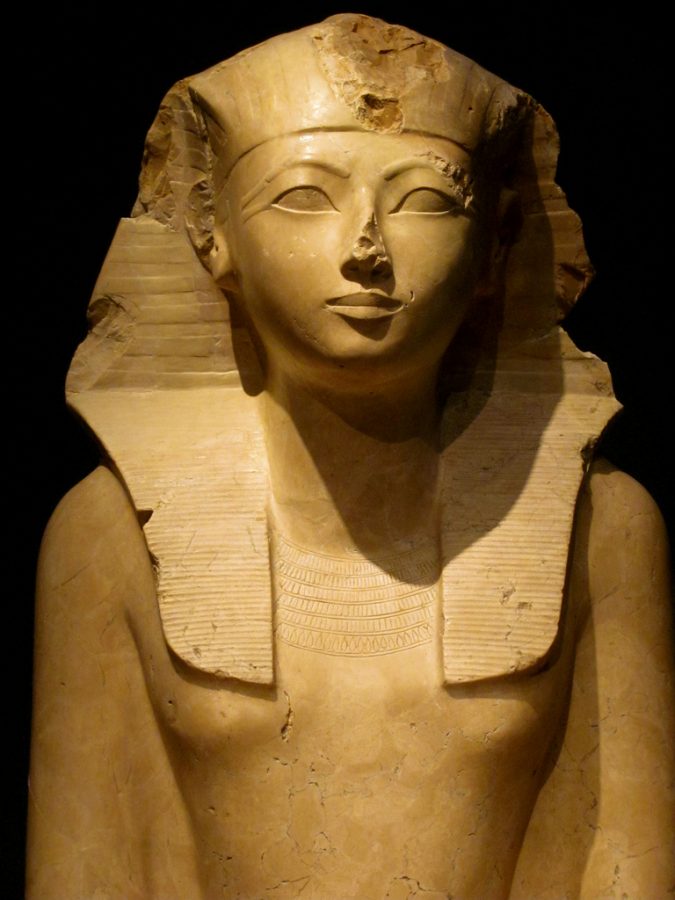Guest Column: “The Pharaoh” by Kristen Cowden
In the 1500s B.C, there was an attack on a Pharaoh in Egypt. But this was not just any attack, as the Pharaoh has been dead for 20 years. This type of attack was called “Damnatio Memoriae.” (The damnation of memory.) Someone had destroyed the Pharaoh’s monuments. The Pharaoh who was the victim was Hatshepsut.
Hatshepsut was born in about 1508 B.C in Ancient Egypt. As the only child of King Thutmose I and Queen Ahmose, she was expected to be queen. Well, that sort of happened. She married her half-brother, Thutmose II, and he inherited his father’s throne. Hatshepsut had one daughter, Neferure, but not a son. When Thutmose II had died, the throne was passed to Thutmose III, son of a lesser harem queen named Isis. According to Britanica.com, “For the first few years of her stepson’s reign, Hatshepsut was an entirely conventional regent. But, by the end of his 7th year of reign, Hatshepsut was crowned as the co-ruler of Egypt.”
When Thutmose II died, Hatshepsut had a problem. She did not have a son, and Thutmose III was too young to make any major political decisions. She, however, became queen like many before her, and served Thutmose III until this coming of age. Then, according to ancient.eu, in 1530 B.C, Hatshepsut proclaimed herself as Pharaoh, and ruled with Thutmose III as a co-regent. This arrangement didn’t last for very long, as Hatshepsut seized power in their second ruling together. This was because Thutmose III is shown as the real ruler, and Hatshepsut follows behind him. According to dls.org, “she began to wear the double crown, which signifies that she rules upper and lower Egypt. In later years, artwork was depicted of her wearing male clothing. For almost 20 years, Hatshepsut ran the country.”
“Hatshepsut’s reign was essentially a peaceful one.” Stated Joyce Tyldesley, author of “Hatshepsut: Ruler of Egypt.” She also stated that “her foreign policy was based on trade and not on war. Restoration and building were important royal duties, and she undertook extensive building programs, namely on the temples of nation God Amon-Re, the Karnak temple complex, and the Dayr al-Bahri temple, a funerary monument to herself.” As well as this, she also built a rock-cut temple in Beni Hasan in the Middle East known in Greek as Speos Artemidos.
Coming to the end of her reign, Hatshepsut allowed Thutmose III to take part in state affairs. After her death, Thutmose III tried to erase all traces of Hatshepsut towards the end of his 33-year reign. Her statues and monuments were torn down, and her name was taken off the list of kings. Hatshepsut’s name was lost until about 1822, when decoding a hieroglyphic script caused confusion, as it was unknown if the Pharaoh was male or female. Later on, Ed Pilkington, author of “Tooth Solves Mummy Mystery,” stated that “Speculation about the riddle has, for years, focused on a separate tomb now known as KV60, which Mr. Carter found and opened in the spring of 1903.Inside he found coffins of mummified geese, which he removed, and the partially disturbed and decaying coffins of two women lying side by side. One bore the inscription of Sitre-In, Hatshepsut’s nurse, the other was anonymous. As the tomb was not royal it received little attention until the Egyptologist Donald Ryan reopened it in 1989. The sarcophagus marked with the name of the wet nurse was taken to Cairo museum, and the second unnamed sarcophagus remained behind. Mr. Hawass decided to re-investigate the mystery surrounding Hatshepsut for a television special to be aired by the Discovery network and his team removed the second sarcophagus to Cairo for a CT scan. The scan revealed that this mummy was an obese woman between the ages of 45 and 60 who had bad teeth. She also suffered from cancer, evidence of which can be seen in the pelvic region and the spine.” This mummy was later found out to be Hatshepsut.
Hatshepsut was once erased from history. Her hard work destroyed, because Thutmose III did not want a female to rule as the Pharaoh. However, Hatshepsut became one of the most successful rulers in Egyptian history, and she still continues to inspire. Although she was once erased form history, she’s back and she’s here to stay.
Your donation will support the student journalists of Dakota High School. Your contribution will allow us to purchase equipment and cover our annual website hosting costs.

Kristin Cowden is a senior at Dakota high school. This is her second year writing for the Dakota Planet, and her first year of being the managing editor...










